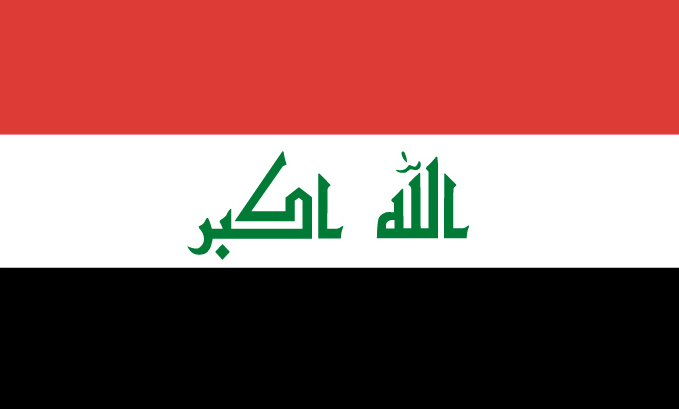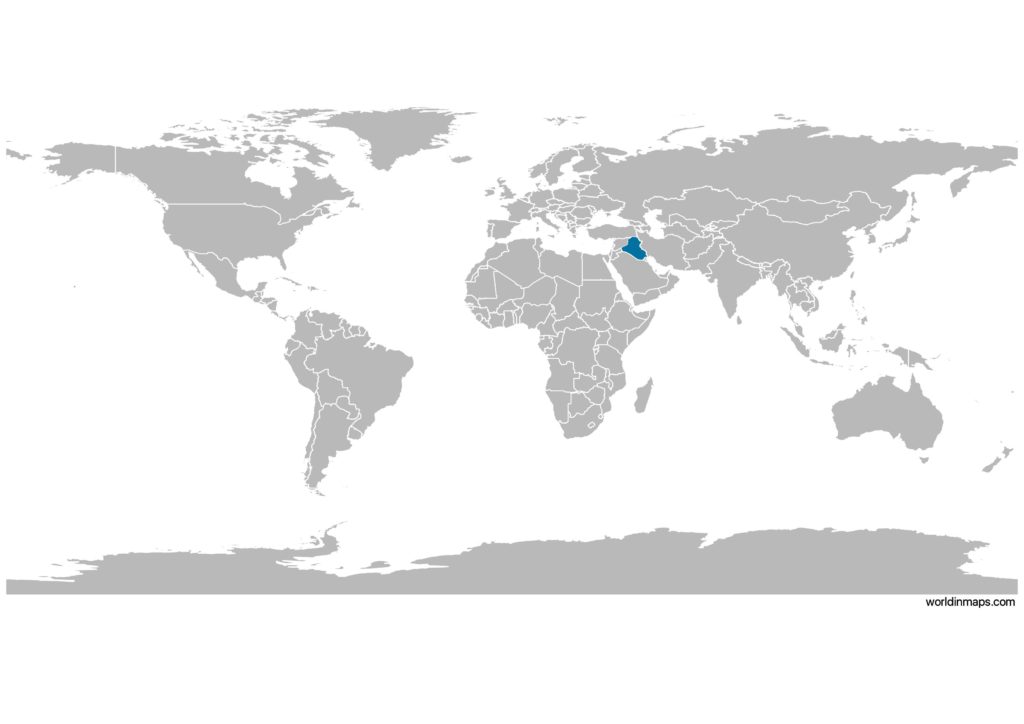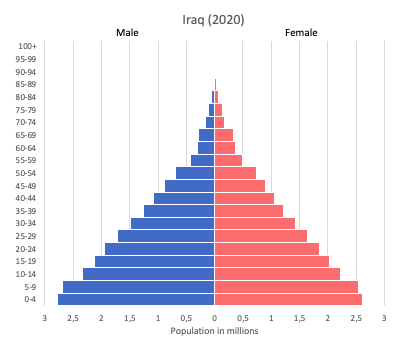Iraq

| Government | |
| Name | Republic of Iraq |
| Arabic | جمهورية العراق |
| Kurdish | کۆماری عێراق |
| Government type | Federal parliamentary republic |
| Capital | Baghdad (7,144,000 (2018)) |
| Currency | Iraqi dinar (IQD) |
| People | |
| Population (2020) | 40,222,503 (36th) |
| Density of population | 82.7 P/km2 (125th) |
| Nationality | Iraqi |
| Official languages | |
| Arabic | |
| Kurdish | |
| Recognised regional languages | |
| Turkmen (a Turkish dialect) | |
| Syriac (Neo-Aramaic) | |
| Armenian | |
| Ethnic groups (1987) | |
| Arab | 75-80% |
| Kurdish | 15-20% |
| Other | 5% |
| Religions (2015) | |
| Muslim (official) | 95-98% |
| Shia | 64-69% |
| Sunni | 29-34% |
| Christian | 1% |
| Other | 1-4% |
| Life expectancy (2020) | |
| Male | 70.7 years |
| Female | 74.6 years |
| Total population | 72.6 years (152th) |
| Homicides | |
| Total (2013) | 10.1 per 100,000 people (34th) |
| Geography | |
| Land area | 437,367 km2 |
| water area | 950 km2 |
| total area | 438,317 km2 (60th) |
| Mean elevation | 312 m |
| Lowest point | |
| Persian Gulf | 0 m |
| Highest point | |
| Cheekha Dar (Kurdish for “Black Tent”) | 3,611 m |
| Land use (2011) | |
| Agricultural land | 18.1% |
| Arable land | 8.4% |
| Permanent crops | 0.5% |
| Permanent pasture | 9.2% |
| Forest | 1.9% |
| Other | 80% |
| Urbanization | |
| Urban population (2020) | 70.9% |
| Rate of urbanization | 3.06% annual rate of change (2015 – 2020) |
| Economy | |
| Labor force (2010) | 8.9 million (57th) |
| Labor force by occupation (2008) | |
| Agriculture | 21.6% |
| Industry | 18.7% |
| Services | 59.8% |
| Unemployment rate (2012) | 16% (175th) |
| GDP (PPP) (estimate 2019) | |
| Total | $733.926 billion (34th) |
| Per capita | $17,952 (76th) |
| GDP (nominal) (estimate 2019) | |
| Total | $250.070 billion (48th) |
| Per capita | $6,116 (97th) |
| GDP by sector (estimate 2017) | |
| Agriculture | 3.3% |
| Industry | 51% |
| Services | 45.8% |
| Exports (2017) | $61.4 billion (46th) |
| Exports partners (2017) | |
| India | 21.2% |
| China | 20.2% |
| US | 15.8% |
| South Korea | 9.4% |
| Greece | 5.3% |
| Netherlands | 4.8% |
| Italy | 4.7% |
| Imports (2017) | $39.47 billion (60th) |
| Imports partners (2017) | |
| Turkey | 27.8% |
| China | 25.7% |
| South Korea | 4.7% |
| Russia | 4.3% |
Iraq on the world map

Iraq is located in Asia and more specifically in the Middle East.
Iraq top 10 largest cities (2018)
- Baghdad (Baghdad)
- Mosul (1,361,800)
- Basra (1,340,800)
- Kirkuk (972,300)
- Erbil (879,000)
- Najaf (747,300)
- Karbala (711,500)
- Sulaymaniyah (676,500)
- Nasiriyah (558,400)
- Amarah (527,500)
Demography
Population pyramid

Age structure data
Estimate for 2020:
- 0-14 years: 37.02% (male 7,349,868/female 7,041,405)
- 15-24 years: 19.83% (male 3,918,433/female 3,788,157)
- 25-54 years: 35.59% (male 6,919,569/female 6,914,856)
- 55-64 years: 4.23% (male 805,397/female 839,137)
- 65 years and over: 3.33% (male 576,593/female 719,240)
Remark: the age structure of a population affects a nation’s key socioeconomic issues. Countries with young populations (high percentage under age 15) need to invest more in schools, while countries with older populations (high percentage ages 65 and over) need to invest more in the health sector. The age structure can also be used to help predict potential political issues. For example, the rapid growth of a young adult population unable to find employment can lead to unrest.
Population from 1950 to 2020
Source: United Nations, Department of Economic and Social Affairs, Population Division (2019). World Population Prospects 2019, Online Edition. Rev. 1.
Evolution of the life expectancy from 1960 to 2018
Source: World Development Indicators, The World Bank
Economy
Agriculture:
wheat, barley, rice, vegetables, dates, cotton; cattle, sheep, poultry
Industries:
petroleum, chemicals, textiles, leather, construction materials, food processing, fertilizer, metal fabrication/processing
Exports – commodities:
crude oil 99%, crude materials excluding fuels, food, live animals
Imports – commodities:
food, medicine, manufactures
Time zone and current time in Iraq
Go to our interactive map to get the current time in Iraq